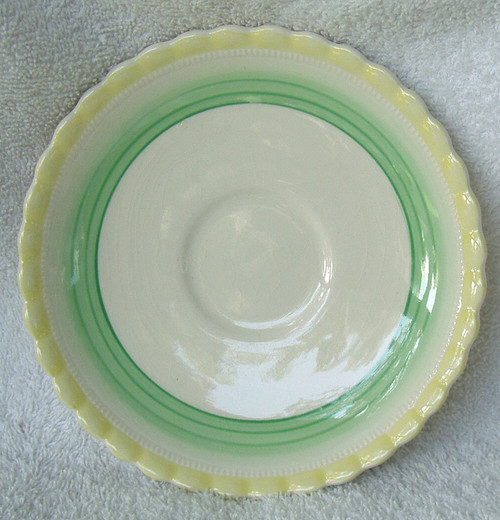Yet more of our beloved family heirloom and collected Meakin chinaware's, these came from the J & G Meakin works then they went across the sea to New Zealand with my grandparents and sometime later I became their "carer" until now I have decided to find new caring homes for them (kids these days don't seem to have any interest in historical English chinaware!)
This advertisement is ONLY for the saucer
Looking for the matching teacup? Try HERE
OR
Looking for the matching side plate? Try HERE
J & G MEAKIN - Saucer
Pattern: Unknown (and goodness knows we have searched over the years but never found it!)
SOL Series (391413 Registration which relates to the SOL trademark NOT the pattern)
Circa late 1930's ~ 1940's
I am going out on a limb with this date estimation, because although the SOL half sun face was used from 1912 onwards, the pattern looks to us very much in the style of 1930's ~ 1940's tableware, bordering on Art Deco and my this date range fits in with my grandparents moving to NZ.
NO flowers
NO fancy artwork
NO Gold gilding at all
Lemon yellow outer scalloped rim colouring with three bands of Lime Green. Colouring is bold but not "garish", it is as though Meakin wanted to produce a design for the times (when Art Deco was a popular choice) and yet, not go overboard with their design.
While not in the class of your fancy "show pony" teasets from Paragon, Aynsley or Royal Albert to name a few, the design is unusual and as an aside, those are very Australian colours!
Probably originally sold as a low cost piece from J&G Meakin, due to the less number of hours taken in the decorative work BUT it may also be that this lack of design intricacy and the lack of gold gilding was also intended by Meakin because it is possible this pattern was produced during WWII years when the British Government placed very severe restrictions on potteries producing fancy china. The government wanted those pottery workers to instead be helping with the war effort and actively discouraged the pottery industry during those war years. Many potteries closed down during WWII and never reopened because of the harsh restrictions placed upon them by the Wartime Concentration Scheme.
Hand painted
Cream/White background
Pronounced scalloped rim
Measurements: 147mm diameter
COSMETIC CONDITION:
I have five saucers left and the condition of each is very similar, so the observations directly below relate to ALL of the saucers and this is followed by any distinctions between saucers
It is unrealistic to expect there to be no flaws and I have listed anything I observed in the following description
COMMON TO ALL SAUCERS:
NO cracks
NO chips
NO artwork damage (scratches etc)
NO discolouration to the artwork - the artist has used bright colours (as opposed to pale tones) which to this day remain vivid but not overly so.
EXTENSIVE (but light) crazing observed on all saucers.
If you do not know what crazing is, it is a cracking of the topmost layer of the glaze (glass like coating). Crazing is often a fact of life with older chinaware, it's mainly an "age thing", think of Grandma's skin - it gets "cracked" too in later years! Crazing can also be promoted by changing environmental conditions (non-air conditioned storing compared to air-conditioned or even the changes of temperature between Winter and the fierce heat of Summer)
What is far more important is whether the crazing has allowed moisture/dirt/bacteria to get into the tiny cracks and cause "spotting' or even more unsightly, brown lines following the glazing cracks.
Fortunately, although light crazing can be seen both topside and underneath the saucer, NO contamination of the glaze has occurred i.e there are NO unsightly discolouration marks, spots or lines caused by the crazing.
Being light crazing, it can be difficult to see and the trick is to either view in sunlight or turn the saucer sideways on an angle so the light reflects differently from the cracks - then you should see them.
Fleabites are present on ALL saucers (on the underside of course) and vary from just one fleabite up to three fleabites on the worst saucers. Again, these can be difficult to see but running a finger across the base will easily find them.
There are no further comments specific to any particular saucer
BACKSTAMP DETAILS:
Blue/Grey colouring
(circular path text)
REGD SOL 391413
(Half SUN grapic)
J&G MEAKIN
ENGLAND
Works artist marks (lime green 'dash') are near the backstamp on three saucers, two however do NOT have the artist marks
These marks were extremely important to the worker as they were paid 'per piece completed' not by the hour, I have no idea why two would not have these marks.









